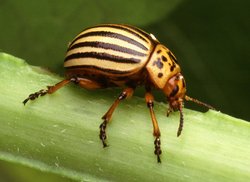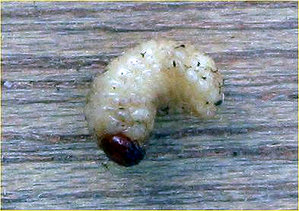Estimates put the total number of species — described and undescribed — at between 5 and 8 million. This is why, when J. B. S. Haldane, a British geneticist, was asked what his studies of nature revealed about God, he replied, "An inordinate fondness for beetles".
Beetles can be found in almost all habitats, but are not known to occur in the sea or in the polar regions. They have a major impact on the ecosystem in three ways: feeding on plants and fungi, breaking down animal and plant debris, and eating other invertebrates. Certain species are agricultural pests in some areas, for example the Colorado potato beetle (Leptinotarsa decemlineata), while other species are important controls of agricultural pests, for example the lady beetles (family Coccinellidae) consume aphids, fruit flies, thrips, and other plant-sucking insects that damage crops.
Anatomy
Bearing in mind the wide diversity and number of species the anatomy of beetles is quite uniform. Beetles are generally characterised by a particularly hard exoskeleton, and the hard wing-cases (elytra) which tend to cover the hind part of the body and protect the second wings, the alae. The elytra are not used in flying, but generally must be raised in order to move the hindwings. In some cases the ability to fly has been lost, characteristically in families such as Carabidae and Curculionidae. After landing, the hindwings are folded below the elytra.
In a few families, both the ability to fly and the wing-cases have been lost, with the best known example being the "glowworms" of the family Phengodidae, in which the females are larviform throughout their lives.
The bodies of beetles are divided into three sections, the head, the thorax, and the abdomen, and these in themselves may be composed of several further segments.
The eyes are compound, and may display some remarkable adabtability, as in the case of the Whirligig beetles (family Gyrinidae), in which the eyes are split to allow a view both above and below the waterline. The dorsal appendage aids the beetle in stalking prey.
Antennae can vary greatly and may be filiform, claviform, flabellate or genticulate.
Oxygen is taken in via a tracheal system: this takes air in through a series of tubes along the body which is then taken into increasingly finer fibres. Pumping movements of the body force the air through the system. Although beetles have blood, it is not used for oxygen transference, although a heart is present.
Development
Beetles are endopterygotes with complete metamorphosis. The larva of a beetle is often called a grub and represents the principal feeding stage of the life-cycle.
The eggs of beetles are minute but may be brightly coloured, they are laid in clumps and there may be from several dozen to several thousand eggs laid by a single female.
Once the egg hatches the larvae tend to feed voraciously, whether out in the open such as with Ladybird larvae, or within plants such as with leaf beetle larvae.
As with lepidoptera, beetle larvae pupate for a period, and from the pupa emerges a fully formed beetle or imago.
In some cases there are several transitory larvae stages and this is known as hypermetamorphosis; examples include the blister beetles (family Meloidae).
Physiology
There are few things that a beetle somewhere will not eat, even inorganic matter may be consumed.
Some beetles are highly specialised in their diet; for example, the Colorado potato beetle (Leptinotarsa decemlineata) opts almost entirely to colonize plants of the potato family (Solanaceae). Others are generalists, eating both plants and animals. Ground beetles (family Carabidae) and rove beetles (family Staphylinidae) are entirely carnivorous and will catch and comsume small prey such as earthworms and snails.
Decaying organic matter is a primary diet for many species, this can range from dung which is consumed by coprophagous species such as the scarab beetles (family Scarabaeidae), to dead animals which are eaten by necrophagous species such as the carrion beetles (family Silphidae). The beneficial impact to the general ecology of these two activities is huge.
Various techniques are employed by many species for retaining both air and water supplies. Predaceous diving beetles (family Dytiscidae) may be the most common example, they employ a technique of retaining air when diving between the abdomen and the elytra.
Reproduction
The larval period of beetles varies between species but can be as long as several years. Adults have an extremely variable lifespan, again, from weeks to years.
Beetles may display some extremely intricate behaviour when mating. Smell is thought to play significant importance in the location of a mate.
Conflict can play a part in the mating rituals for example in species such as burying beetles (genus Nicrophorus) where localised conflicts between males and females rage until only one of each is left, thus ensuring reproduction by the strongest and fittest. Many beetles are territorial and will fiercly defend their small patch of territory from intruding males.
Pairing is generally short but in some cases will last for several hours. During pairing sperm cells are transferred to the female to fertilise the egg.
Parental care
As befitting such a large order, the parental care between species varies widely. It ranges from the simple laying of eggs under a leaf to scarab beetles, which construct impressive underground structures complete with a supply of dung to house and feed their young.
There are other notable ways of caring for the eggs and young, such as those employed by leaf rollers, who bite sections of leaf causing it to curl inwards and then lay the eggs, thus protected, inside.
Generally the number of eggs laid is an indicator of the level of parental care subsequently employed, as they are inversely proportional.
Read more at Wikipedia.org




